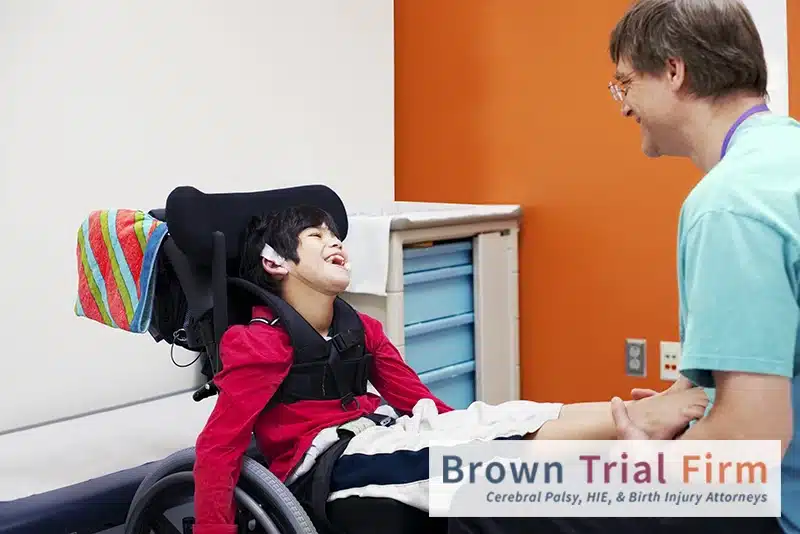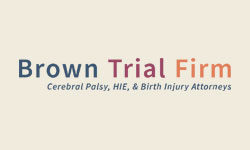Facing the reality that your child’s cerebral palsy or hypoxic-ischemic encephalopathy (HIE) may have been caused by a medical mistake is an incredibly difficult situation for any family. The confusion and heartache that accompany questions like “What went wrong?” and “Could it have been prevented?” can be overwhelming.
At such a critical time, getting clear answers and understanding your legal rights are paramount. At Brown Trial Firm, Missouri birth injury attorney Laura Brown uses her compassion and legal expertise in birth injury law to make the process easier. Her firm is dedicated to helping families like yours uncover the truth and seek the compensation they need to secure the best possible future for their children.
If you suspect medical negligence may have played a role in your child’s condition, reach out to Brown Trial Firm today for a free consultation so you can get the support and advocacy you need.
What’s the connection between HIE and cerebral palsy?
Some people have heard the term “hypoxic-ischemic encephalopathy” (or HIE) used before but might not be entirely sure what it means or how it relates to cerebral palsy.
HIE occurs when a baby’s brain is deprived of sufficient oxygen and blood flow around the time of birth, which can lead to brain injury. The connection between hypoxic-ischemic encephalopathy (HIE) and cerebral palsy (CP) lies in the brain damage that HIE can cause.
When specific areas of the brain that are responsible for controlling motor functions and maintaining muscle coordination are damaged, it can result in cerebral palsy, which is characterized by impaired movement control, muscle stiffness, and coordination difficulties.
Essentially, the severity and location of a child’s brain injury determine if and to what extent they will experience cerebral palsy symptoms. Thus, HIE is one of the known medical conditions that can lead to cerebral palsy due to its impact on the brain’s motor control centers.
What are the symptoms of HIE?
The symptoms of hypoxic-ischemic encephalopathy vary depending on the severity and location of the brain damage but may include poor muscle tone, weak reflexes, difficulty feeding, abnormal crying or grunting, seizures, and lethargy or coma.
The permanence of these symptoms largely depends on the extent of the brain injury and the effectiveness of immediate treatment, such as therapeutic hypothermia (brain cooling treatment), which can reduce the extent of brain damage.
What are the early signs of cerebral palsy?
Early signs of cerebral palsy can appear in infants as young as a few months old but may not be evident in some children for a year or more. Some of the key symptoms to watch for include:
- Delayed developmental milestones. This can include rolling over, sitting, crawling, or walking later than expected for their age.
- Muscle stiffness or floppiness. Muscles may feel tight and rigid or, conversely, loose and weak.
- Abnormal posture or movement. An infant with CP might favor one side of their body over the other, have tremors, or exhibit jerky or uncoordinated movements.
- Feeding difficulties. Problems sucking, swallowing, or coordinating suck-swallow-breathe patterns may also be an early sign of CP.
- Excessive drooling. This can be a sign of weak oral muscles, which may indicate cerebral palsy. Although there are other causes of drooling in infants, like teething, that don’t indicate a problem.
These are just some signs, and not all babies with these symptoms will have CP. However, observing these signs, especially if they persist or if multiple symptoms are present, may warrant further evaluation by a pediatrician to determine if they’re due to cerebral palsy or another developmental issue.
Conditions related to cerebral palsy
Learn about primary conditions, secondary conditions, associative conditions, and co-mitigating factors related to CP.
Can someone have a mild case of cerebral palsy?
Yes, cerebral palsy can vary significantly in its severity, and someone can indeed have a mild case of cerebral palsy. In mild CP, the symptoms may be less pronounced, and the individual might experience only slight challenges with motor skills.
People with mild cerebral palsy may walk a little awkwardly but might not need any assistive devices. They can typically manage their daily activities, have independent mobility, and may require minimal assistance. The effects of mild cerebral palsy might even go unnoticed to the untrained eye in some cases.
In many cases, individuals with mild cerebral palsy may be able to lead relatively “normal” and active lives, especially if treatment and therapies are started early.
Can a child outgrow cerebral palsy?
No, a child cannot outgrow cerebral palsy. Cerebral palsy is a permanent, lifelong condition that results from brain damage or abnormalities in brain development that do not change over time.
However, while cerebral palsy itself does not improve or worsen, early and continuous interventions can significantly enhance an individual’s ability to manage symptoms and improve motor functions.
Children with cerebral palsy can benefit greatly from ongoing therapies, such as physical therapy, occupational therapy, and speech therapy, which can help improve their mobility, muscle control, and communication skills. Assistive technologies and adaptive equipment can also play crucial roles in improving their quality of life and independence.
Surgical options for spastic cerebral palsy
Learn about the different surgical treatment options available to decrease pain and increase mobility for people with spastic cerebral palsy.
How do I know if my child’s cerebral palsy or HIE was caused by a medical error?
Determining if your child’s cerebral palsy or HIE was caused by a medical mistake involves evaluating the circumstances surrounding the pregnancy, labor, delivery, and immediate postnatal care, typically with the help of a birth injury attorney.
Below are some factors and signs that could indicate a medical mistake occurred:
- Inadequate monitoring. Failure to properly monitor the fetal heart rate and mother’s condition during labor could mean that signs of fetal intolerance to labor, such as oxygen deprivation, were missed, which could lead to HIE and, subsequently, cerebral palsy.
- Delayed response to distress. If signs of fetal or maternal distress were evident but there was a delay in responding, such as not performing a necessary cesarean section (C-section) quickly, this could have deprived the baby of oxygen long enough to cause brain damage.
- Improper use of delivery instruments. Incorrect or excessive use of vacuum extractors or forceps can cause direct physical trauma to the baby’s head, leading to brain injuries that result in cerebral palsy.
- Failure to treat medical conditions. Not adequately treating or managing maternal health issues like infections, high blood pressure, or diabetes can adversely affect the baby, potentially leading to conditions like HIE and CP. Additionally, failure to treat certain conditions, like kernicterus (severe jaundice), in a newborn can also lead to cerebral palsy.
- Mismanagement of the birth process. This includes errors in handling complications such as umbilical cord prolapse, placental abruption, or excessive bleeding, which can all lead to oxygen deprivation.
If any of these situations apply to your case or if your instincts are simply telling you something went wrong, it’s important to consult with a knowledgeable birth injury attorney who can help you understand your legal options.
An attorney can conduct a thorough investigation, obtain expert medical opinions, determine whether medical negligence likely occurred, and guide you through the necessary steps to pursue a claim if one is warranted.
Cerebral palsy resources for Missouri families
For families in Missouri dealing with cerebral palsy, there are several valuable resources available to provide support, therapy, and advocacy, including:
St. Louis Children’s Hospital – Cerebral Palsy Center
Specializes in providing comprehensive care and treatment for children with cerebral palsy. The center offers a multidisciplinary approach, including physical, occupational, and speech therapies.
- Address: One Children’s Place, St. Louis, MO 63110
- Phone: (314) 454-5437 or (800) 678-5437
Aims to assist people with developmental disabilities—including cerebral palsy—by providing services that help them live, learn, work, and play in their communities.
- Address: 11933 Westline Industrial Dr, St. Louis, MO 63146
- Phone: (800) 200-2119
Get the help your family deserves from an experienced Missouri cerebral palsy attorney
If your family is navigating the challenges of cerebral palsy or HIE that you believe may be the result of a medical error, please know that help is available.
Experienced Missouri birth injury attorney Laura Brown is dedicated to helping families like yours understand their rights and recover the compensation their child needs for medical expenses, ongoing care costs, therapy, adaptive equipment, pain and suffering, and more.
Her compassionate approach and deep expertise in Missouri birth injury law mean that she’s well-equipped to fight for the justice and support your family deserves.
Reach out to Brown Trial Firm today to discuss your case and find out how we can help secure a brighter future for your child.




